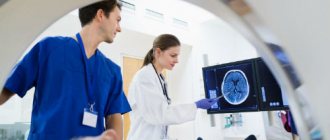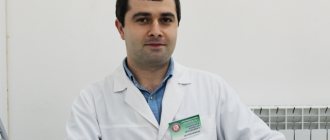Residual encephalopathy is a common diagnosis in neurological practice. Usually it means suffering of the brain (encephalon - brain, pathia - suffering), under the influence of some transferred factor. After all, the term residual means persisting.
There may be many reasons for the development of residual encephalopathy:
- Perinatal (most often hypoxic) damage. This includes birth trauma, hypoxia during childbirth and other reasons. This type of residual encephalopathy is typical for children, although sometimes it is permissible to use the term cerebral palsy (cerebral palsy) if the signs of damage affect the motor sphere and are expressed quite roughly.
- Traumatic brain damage. Although sometimes it is acceptable to use the term post-traumatic encephalopathy.
- Dysontogenetic conditions (Arnold-Chiari malformation, for example, congenital hydrocephalus, etc.). By and large, they affect any features of abnormal brain development.
- Past neuroinfections (tick-borne encephalitis, meningoencephalitis of various etiologies, etc.).
- Previous neurosurgical interventions, including those for brain tumors, with the appearance/maintenance of a neurological defect after them.
- Other traumatic factors suffered that left neurological symptoms, if there is a full correlation with the traumatic event.
Causes
Causes of minor cerebral dysfunction (MMD):
- genetic influences;
- maternal health problems during pregnancy;
- difficult childbirth;
- encephalitis (subcortical, cortical, cerebellar, brainstem);
- early childhood unconsciousness;
- injuries affecting the mediobasal or mesencephalic part of the brain;
- diencephalic syndrome;
- influence of nutrition.
Products that support hyperactivity, fatigue, behavior disorders and activity in children:
- food containing dyes and artificial flavors (there are many of them, most are made from coal tar);
- ordinary food components (in chemically processed fruit juices, chocolate, ready-made cereals, etc.);
- various treats (desserts, ice cream, nuts, milk);
- difficult to digest foods (eggs);
- simple sugars (cakes, candies, chocolate, ice cream, cookies).
Sometimes, when diagnosed with MMD, visual disturbances are present - astigmatism, amblyopia, etc.
Symptoms
Minimal brain dysfunction in children is manifested by the following symptoms:
- attention deficit disorder;
- hyperactivity;
- hypoactivity;
- uneven development of intellectual abilities;
- disorder in the dynamics of mental processes;
- anxiety;
- low endurance;
- impulsiveness;
- mood swings;
- perception disorders, etc.
These signs do not always mean MMD; in neuroscience, factors of the social environment, attention seeking, conduct disorder or temperamental characteristics are taken into account.
PsyAndNeuro.ru
We are currently on the verge of approving a new International Classification of Diseases, 11th revision (ICD-11), which will differ significantly from the previous version. In the first issue of 2021 of the journal “Issues of Mental Health of Children and Adolescents,” an article was published by E. V. Korn and T. A. Kupriyanova from the Moscow Research Institute of Psychiatry, a branch of the Federal State Budgetary Institution “Federal Medical Research Center for Psychiatry and Narcology named after V.P. . Serbsky”, in which the authors, based on ICD-10 and ICD-11, consider the difficulties of classification in the field of child psychiatry.
In the new ICD-11, the heading “Emotional and behavioral disorders, usually beginning in childhood and adolescence” (F90 - F98) is missing. All conditions described in this section have been moved to other relevant sections of ICD-11. The fact is that this part of the classification contained individual symptoms, without linking them to any disease, without the ability to trace the relationship and a single pathogenesis. Also, this section was static in nature, which forced several diagnoses to be made. At the same time, some “childhood” mental disorders (for example, autism spectrum disorders, ASD) did not have “analogs” in adulthood, and therefore, when the patient reached 18 years of age, the diagnosis had to be “changed.”
ICD-11 introduced a new category “Neurodevelopmental disorders”, which includes intellectual development disorders, ASD, disorders of speech development and motor skills. The ASD group has expanded: it now includes early childhood autism, atypical autism, and Asperger syndrome. This was done to focus attention on the preservation of intelligence in order to select a more suitable educational route for the patient in the future.
For the purpose of destigmatization, the term “mental retardation” has been replaced by “intellectual development disorders.” As diagnostic criteria, it is proposed to evaluate not only the level of mental abilities, but also the degree of rehabilitation potential. Also, this diagnosis is preliminary until the age of four.
The diagnosis of “Hyperkinetic disorders” has been renamed to “Attention deficit hyperactivity disorder” (ADHD). As with the DSM-5, there is no precise age at which this disorder can be diagnosed. The diagnosis of “Hyperkinetic behavior disorder”, which combines ADHD and behavioral disorders, was excluded.
The criteria for mania in bipolar affective disorder in children and adolescents, as in adults, suggest assessing the level of energy activation. A new group “Destructive behavior or dissocial disorders” has also been identified, combining oppositional defiant disorder in children and dissocial personality disorder in adults. There are types: with/without irritability and aggression, normal/disturbed social interaction.
A new group “Anxiety and Fear-Related Disorders” has appeared. It will include childhood diagnostic categories such as selective mutism (F94.0) as well as separation anxiety disorder (F93.0). One of the subgroups of this section, called “Factors associated with fear,” also includes fears that began in childhood.
All mental disorders in ICD-11 are considered taking into account the characteristics of age, that is, in an ontogenetic context. And this is one of the main differences between ICD-11 and ICD-10.
Prepared by: Wirth K. O.
Sources:
- E. V. Koren, T. A. Kupriyanova “Current Issues of classification in child psychiatry in the perspective of ICD-11”, “Issues of mental health of children and adolescents”, 2018; With. 27 – 35
- Wolfgang Gaebel, Jürgen Zielasek, Geoffrey M. Reed. Mental and behavioral disorders in the ICD-11: concepts, methodologies, and current status. Psychiatr. Pol. 2017; 51(2): 169–195
Classic treatment
Once the diagnosis of MMD is made, the neurologist prescribes appropriate treatment. Therapy includes several methods.
Pharmacotherapy
Minimal brain dysfunction can be treated with several groups of drugs.
Nootropics
This is the first line of drugs used in drug therapy. They increase blood flow through the blood vessels of the brain, providing a greater supply of oxygen and glucose (substances necessary for nerve cells). This group includes:
- Piracetam;
- Encephabol;
- Energy ball.
Psychostimulants
Suppresses symptoms of insufficient central nervous system activation, such as inattention and hyperactivity.
But psychostimulants lead to depression of growth hormone in children and, consequently, to a decrease in body height and weight (compared to peers), and have side effects. There is a risk of addiction when using them; their effect is not permanent.
Thymoleptics (antidepressants)
They increase the level of serotonin (a neurotransmitter that ensures good health) and suppress the symptoms of hyperactivity. Representatives of this group:
- Deprex;
- Prozac;
- Seropram.
EEG-BOS
EEG biofeedback is a very specific method for increasing desired activation of the nervous system. Effect of therapy:
- training attention and concentration, self-control and self-discipline (calming impulsivity, hyperactivity);
- improvement of intellectual indicators;
- self-education of the brain through biofeedback.
When the brain receives an instant message that its waves are disordered, it can learn to correct them.
Electrodes attached to the head record brain waves. The brain wave is visible on the screen. It is translated into the form of a video game, which the patient “plays” only with the power of his thoughts and will, without a keyboard or mouse. The game is controlled by brain activity. When activity in the desired brain wave increases, the “player” experiences successful results. With increasing activity in an undesirable structure, success in the game is leveled out. The brain gradually responds to the motivational instructions that the computer gives it, rewarding it for good results in the game. This is how the brain develops the process of learning new, more appropriate frequencies of brain waves. This is the brain itself working on itself.
Advisory corrective procedures
For various disorders when diagnosing MMD in a child, certain procedures are used in neurology:
- for speech defects – speech therapy;
- for behavioral disorders - changing the regime, changing the attitude towards the child, autogenic training;
- learning disabilities – special corrective procedures.
Consult specialists at the pedagogical and psychological center about corrective action options.
Self-medication
Self-medication uses dietary changes and traditional therapeutic methods.
Healthy eating:
- Exclusion from the diet: sweets, processed foods, instant foods, sweet sodas, and other processed foods with excess added dyes and flavors.
- Inclusion in the diet: fruits, vegetables, whole grains, cereal sprouts (sources of B vitamins), legumes (sources of lecithin).
Nutritional supplements, vitamins and minerals:
- Ginkgo biloba - increases venous blood flow, thereby giving nerve cells a greater supply of oxygen and glucose.
- Magnesium and calcium are necessary for the functioning of nerve cells.
- B-complex – important for the proper functioning of the nervous system.
- Lecithin – improves memory.
Natural and Complementary Treatments:
- aromatherapy;
- yoga;
- kinesiology;
- constitutional homeopathy.
Treatment of minimal brain dysfunctions in children at CORTEX MC.
Brain dysfunctions (MMD) in children are the most common form of neuropsychiatric disorders in childhood: the incidence rate among preschool and school-age children reaches 5–20%. With MMD, there is a delay in the rate of development of the functional systems of the brain that provide such complex integrative functions , such as speech, attention, memory, perception and other forms of higher mental activity. In terms of general intellectual development, children with MMD are at the normal level, but at the same time they experience significant difficulties in school learning and social adaptation. Due to focal damage, underdevelopment or dysfunction of certain parts of the cerebral cortex, MMD in children manifests itself in the form of motor and speech development, formation of writing skills (dysgraphia), reading (dyslexia), counting (dyscalculia). The term “minimal brain dysfunction” became widespread in the 1960s, when it began to be used in relation to a group of conditions of varying etiology and pathogenesis, accompanied by behavioral disorders and learning difficulties not associated with a general lag in intellectual development. Due to the diversity of clinical manifestations and the heterogeneity of factors underlying the etiology and pathogenesis of MMD, diagnostic criteria have been developed for a number of conditions previously considered within the framework of MMD.
List of nosological forms considered according to ICD 10 within the framework of the MMD.
| ICD code - 10 | Nosological form of the disease |
| Section F 8 | Psychological development disorders |
| F 80 | Speech development disorders |
| F 81 | Disorders of development of school skills: dysgraphia, dyslexia, dyscalculia |
| F 82 | Developmental disorders of motor functions - dyspraxia |
| Section F 90-F98 | Behavioral and emotional disorders, usually beginning in childhood and adolescence |
| F 90 | Attention deficit hyperactivity disorder |
| F91 | Behavioral disorders |
The reasons for the development of minimal brain dysfunction are not fully understood.
The main factors influencing the appearance of cerebral dysfunction are:
• hereditary predisposition;
• hemolytic disease occurs in the fetus, which develops in the event of a Rh conflict with the mother, which leads to the destruction of the child’s red blood cells;
• various diseases and infections that a woman suffered during pregnancy;
• maternal anemia: malnutrition, vitamin deficiency, etc.;
• severe toxicosis;
• threat of termination of pregnancy (miscarriage), for example, due to severe stress, hypertonicity or hypotonicity of the uterus, etc.;
• any harmful external influences on a woman during pregnancy: radiation, viruses, infections, bacteria, etc., this also includes poor environmental conditions;
• lack of oxygen (hypoxia), suffocation of the fetus (asphyxia) during labor, for example, the umbilical cord entwining the baby’s throat, or a long passage of the fetus through the birth canal;
• premature birth;
• weak labor activity or, conversely, rapid labor;
• damage to the spinal cord during childbirth;
• lack of nutrition in infancy and early childhood;
• development of diseases in the baby such as heart disease, bronchial asthma, infectious diseases, etc.
MMD begins to manifest itself most clearly when children are preparing for school or in the lower grades. It can be observed that the child does not assimilate new information well and has difficulty remembering it; he has problems with handwriting and writing in general. And the point is not that the child has a low intellectual level or does not want to learn, the problem is that MMD affects every sphere of life.
Clinical manifestations of minimal brain dysfunction vary depending on the age of the child:
In infants, the main symptoms of MMD are:
• increased tearfulness and moodiness;
• increased heart rate, sweating, breathing rate;
• presence of spasms and convulsions;
• disorders of the gastrointestinal tract: frequent regurgitation, diarrhea, etc.;
• difficulty sleeping and falling asleep.
The main syndromes that occur in school-age children:
Hyperactivity and attention deficit disorder: - fidgeting in a chair, inability to sit in one place); - the child leaves games and other things unfinished, cannot concentrate on one thing for a long time, begins many actions at once; - often loses things, falls, collides with objects and others; - enters into conflicts, is capricious, aggressive towards loved ones and himself; - problems arise with subjects that require high concentration of attention, long-term mental operations (mathematics, essays, memorizing poems). Sphere of attention: voluntary memorization is impaired, concentration and volume are reduced. It manifests itself mainly in the fact that the child is absent-minded and cannot do the same thing for a long time, especially if it requires mental stress. Speech sphere: the first thing you should pay attention to is the child’s articulation - unclear pronunciation of words and sounds. You can also notice that the child sometimes does not perceive other people’s speech well and does not assimilate information by ear (impaired auditory-verbal memory). This manifests itself in poor vocabulary, difficulty in retelling what was heard or read, and difficulty constructing long sentences. Memory disorders: manifest themselves mainly in difficulties in mechanical memorization, i.e. through repeated repetition. Motor sphere: in such children one can often observe violations of fine motor skills of the hands. This mainly manifests itself in general awkwardness of movements and handling of objects. The child has difficulty fastening small buttons, tying shoelaces, using scissors, and sewing; at school, difficulties arise with neat handwriting and reading speed. Spatial orientation: such children often confuse “left” and “right”, can write all letters in mirror images, etc. Emotional sphere: lability of emotional state. Children with this disorder rapidly change their mood from depressed to euphoric. Unreasonable outbursts of aggression, anger, and irritability may occur, both towards others and towards oneself. One can observe traits of infantility (capriciousness), hysterical personality, and lack of independence.
The maximum severity of MMD manifestations often coincides with critical periods of psychospeech development.
— The first period includes the age of 1–2 years, when intensive development of cortical speech zones and active formation of speech skills occur. - The second period occurs at the age of 3 years. At this stage, the child’s stock of actively used words increases, phrasal speech improves, and attention and memory actively develop. At this time, many children with MMD exhibit delayed speech development and articulation disorders. — The third critical period refers to the age of 6–7 years and coincides with the beginning of the development of written language skills (writing, reading). Children with MMD of this age are characterized by the development of school maladjustment and behavior problems. Significant psychological difficulties often cause various psychosomatic disorders and manifestations of vegetative-vascular dystonia. During adolescence, a number of children with MMD experience increased behavioral disturbances, aggressiveness, difficulties in relationships in the family and school, academic performance deteriorates, and a craving for alcohol and drug use appears.
Therefore, the efforts of specialists should be aimed at timely detection and correction of MMD.
Treatment of MMD is complex and includes several areas: - Psychological and pedagogical measures: 1. The child should be provided with sufficient physical activity: in the case of hyperactivity, it is necessary to give vent to emotions and mobility, and in cases of hypoactivity it is necessary that the loads are not unbearable, but at the same time time stimulated activity. 2. It is necessary to ensure a healthy psychological atmosphere in the family and environment. It is important to create calm and stability, because they will help correct mood swings. Overly strict discipline should not be allowed, but one should also not be overprotective or indulge in whims. 3. It is necessary to observe certain routine moments (go to bed and get up at the same time, set aside time for work and rest, etc.). 4. Contribute to the development of the child’s weaknesses: play games that require fine motor skills, memorize fairy tales and poems, but not mechanically - try to interest the child in the content, etc. An important condition for treatment will be classes with a psychologist, special teachers and speech therapist. Drug therapy occupies an important place in the treatment of MMD along with methods of psychological and pedagogical correction. Drug therapy is prescribed according to individual indications in cases where cognitive impairment and behavioral problems in a child with MMD are so pronounced that they cannot be overcome only with the help of psychological and pedagogical measures. Currently, various groups of drugs are used in the treatment of MMD, including antioxidants (Mexidol, Actovegin), nootropic drugs (Cerebrolysin, Encephabol, Semax, Cortexin). However, the above methods, while affecting individual symptoms of MMD, do not affect the causes of the disease as a whole and, as a result, do not always give a pronounced positive effect overall.
Specialists of the CORTEX MC have developed a new highly effective method of treating children suffering from various forms of mental and speech developmental delays, including MMD - BIOPHYSICAL ACTIVATION of speech centers of the brain. The main neurospecific treatment - BPA - affects the brain through the projection zones of speech, praxis, gnosis; on the articulatory apparatus, promotes their activation, stimulates the development of stable connections and improves the functioning of the first and second signaling systems of the brain, which integrate all signals from the outside world and form the child’s meaningful responses, his speech, memory, attention, and promotes his socialization. The treatment technique is based both on the activation of the speech centers themselves (Broca's area, Wernicke's area, angular gyrus, etc.), and on the restoration of lost connections not only between centers, but also interhemispheric ones. In addition, scattered interneuronal connections of speech centers with other areas of the brain involved in speech function are restored. Treatment of MMD should be comprehensive, which leads to a more pronounced and lasting positive effect. Specialists from CORTEX MC have developed a new highly effective treatment complex for children suffering from various forms of mental retardation and MMD. The components of the treatment process are: diagnosis, the main neurospecific pathogenetic treatment - BFA of the speech centers of the brain and a complex of auxiliary treatment. At the CORTEX MC, each patient must undergo a comprehensive, comprehensive examination : an initial examination by a pediatric neurologist, consultation with a pediatrician, testing of speech functions by a speech therapist-speech pathologist, psychological counseling, computer EEG and evoked potentials of the brain and spinal cord, as well as a neuroimmunological examination of blood for neurotropic viruses (cytomegalovirus, rubella, Epstein-Barr, herpes simplex and others), study of the level of antibodies to specific proteins of the central nervous system in order to determine the degree of damage and hypoxia of nervous tissue. The study allows us to identify a hidden neuroinfection that inhibits the maturation of speech, gnostic and praxis centers. All of the above diagnostic methods make it possible to predict the further course of the disease and formulate the most optimal treatment complex for each patient, as well as confirm, clarify or change the diagnosis.
Auxiliary treatment is a complex that includes the most advanced medical technologies for the symptomatic treatment of various forms of mental retardation, mental retardation and malignant retardation:
1. Neuroprotective therapy for regulating the integrative activity of the brain, lymphatic intercellular therapy and endonasal cortexin electrophoresis are techniques that allow small doses of cerebroprotectors to be delivered endolymphatically; they directly enter the brain tissue, bypassing the blood-brain barrier.
2. Transcranial and transvertebral micropolarization successfully combines non-invasiveness and selectivity of influence, allowing to improve or restore motor, mental, and speech functions. The direction of influence is achieved through the use of small areas of electrodes located on the corresponding cortical (frontal, motor, temporal, etc.) or segmental (lumbar, thoracic, cervical, etc.) projections of the brain or spinal cord.
3. Differentiated segmental massage, which helps normalize muscle tone and has relaxing and sedative effects in case of hyperexcitability of the child.
4. For the purpose of neurophysiological regulation of the stato-kinetic function of the central nervous system, the CORTEX MC uses a unique development of the Center for Aerospace Medicine - the plantar support load simulator “Corvit”. The device allows you to simulate indicators of the physical impact on the foot when walking, which helps to normalize the processes of excitation and inhibition in the central nervous system, the development and restoration of coordination of movements. The device ensures the occurrence of an impulse and its delivery to the cerebellar cortex, allowing indirect formation and improvement of speech skills and perception of the surrounding world.
5. Speech therapy correction includes diagnosis of the degree of speech disorders, daily classes aimed at improving speech function and speech therapy massage to correct various types of dysarthria and dysphagia;
6. Psychological assistance includes: individual consultations, pathopsychological tests (study of attention, memory, thinking, characteristics of the emotional and personal sphere) and neuropsychological tests (study of lateral preferences, motor and sensory asymmetry, general awareness, cognitive, speech, mnestic, intellectual functions). An experimental psychological report is drawn up and given to parents. The specialist selects an individual psychological program for correcting disorders in a particular area for a particular child and further recommendations.
7. Method of audiovocal training RUSTOMATIS according to the method of A. Tomatis. In the 50s of the 20th century, while the author was studying the method of influencing the human brain with sounds of different frequencies, it was discovered that the ear not only hears sounds of different frequencies and laterality - the vibrations are converted into electrical impulses that enter the brain. Currently, a special device for recording high-frequency and low-frequency components has been developed - the “electronic ear”. By alternating such music through tension and relaxation, the child’s middle ear apparatus – the hammer and stapes – is trained, with the help of which the range of perception of external factors expands, concentration of attention increases, new information enters the brain and, as a result, many disorders and disorders disappear. The audio correction system configures, trains and “trains” the vestibular apparatus and auditory analyzer systems to correctly process incoming information.
In the process of complex treatment, a physiological, consistent interaction of all areas of the brain associated with speech production, involved in the control of higher cognitive functions and associative systems of the brain, is formed. The child’s memory improves, attention increases, fine motor skills develop, and thinking becomes more active. During treatment, it is possible to significantly improve speech and behavior, children become calmer, better assimilate new information, and their success in school increases.
Early detection and correction of symptoms of minimal brain dysfunction is very important when the processes of morphofunctional development of the central nervous system continue, its plasticity and reserve capabilities are great. If the diagnosis was made accurately and on time, parents and teachers, doctors interact actively and were able to develop the necessary tactics of communication with the child, then with age the person will compensate for almost all the disorders, and he will be able to live a full life.
Upbringing
When raising children and adolescents with minimal brain dysfunction, it is recommended to follow certain principles.
Quiet, emotionally harmonious family environment
It is important to show your child love so that he is confident in it. Parents should try to remain calm and level-headed in tense situations; The nervousness of the parents is transmitted to the child, the effect of hyperactivity intensifies. Let him know the stability of parental support, family background, security, understanding of his problems.
Family order
The child must get used to the usual daily routine - sometimes very stereotypical. He must know what is expected of him in the family. The rules of coexistence must be clearly defined so that the child knows when he crosses them and when he does not. The children's world should be clear and well organized.
Order is important because a child has no “internal order” of his own, only chaos, which can make everything else seem chaotic to him.
Subsequence
Consistency does not mean terror, on the contrary. It is important to act kindly and very patiently. Parental instructions and the completion or non-compliance of tasks must be adequately monitored. If a task is beyond the child’s capabilities, you should help him, sometimes just support him.
More frequent nonviolent control ensures that the child automates the necessary actions, making the need for control less significant.
Unification of education
If one parent is consistent in parenting and the other is not, the child takes advantage of the “weaker” parent or does not listen to either parent. Therefore, it is important to unite education and agree on precise rules. Inconsistency in parenting almost always leads to worsening symptoms of a child's cerebral dysfunction.
Focusing on the positive aspects of a child's personality
Let your child experience success. Rather, ignore negative behavior (if possible) and praise him for doing the right thing. Remember: the supply of punishments will quickly be exhausted, the child will get used to them, which will minimize their effect.
Direction of the child's activity
Increased activity not only helps you focus on multiple tasks at once, but also directs your energy in the right direction. Therefore, it is advisable not to suppress activity, but to allow children to “discharge” whenever possible. It is important to provide your child with ample opportunities to relax. This can also be done during certain activities by changing activities, changing positions, etc.
For most children, simple, clearly stated, reasonable, and understandable rules are appropriate.
It is advisable to follow these principles even when raising children without minimal brain dysfunction. But for children with ADHD, they are a vital necessity.
Correction and development work for delayed speech development
Speech problems in children can be prevented through timely prevention of speech disorders.
Speech therapy work
It includes a number of simple and effective activities (games):
- with objects and fingers, aimed at developing fine motor skills;
- on the development of phonemic hearing, auditory perception;
- aimed at developing the prosodic side of speech, that is, voice, diction, breathing;
- to develop the ability for onomatopoeia;
- on the development of the articulatory apparatus.
Prevention of intrauterine developmental disorders
If necessary, parents can also contact the speech development center at the preschool educational institution. Most of them provide a speech therapy class (or, as an option, they have a special group) that allows you to level out the level of speech development and correct mental retardation.
In general, it is worth noting that the Federal State Educational Standard regulates the work of schools and preschool educational institutions, prescribing what exactly the educational standard according to which the institution operates should include, and how the work of a speech therapist is structured with a child entering the preparatory, junior, middle, and senior levels.
Understanding what the psychology of children with speech disorders is like, parents will be able to take timely measures. This will help level out the child’s speech development at an early age.
Preventing the effects of MMD on a child
In preschool age, timely recognition of the symptoms of minimal brain dysfunction is important.
At school and at home you need to:
- help the child achieve success (search for positive aspects, highlight certain abilities, etc.);
- teach him to perform various tasks (feel their meaning, purpose, necessity);
- help you find your place in the team (increase prestige, do not point out character traits);
- help to realize oneself;
- keep in mind that rewards “reinforce” correct behaviors; therefore, do not spare praise for little things (even for attentiveness);
- appreciate efforts (even if the result is not entirely successful);
- set short-term goals for your child;
- individually test his knowledge (outside the classroom atmosphere full of irritants);
- provide the child with enough love;
- monitor fatigue and attention during classes, take into account increased fatigue in class and during the day (especially in the first year of school).
Prenatal prevention
For these purposes, the so-called “prenatal education” is a method of specific stimulation of the fetus during pregnancy. Thanks to precise sound stimulation, the fetal nerve cells are activated and the maturation of brain activity is accelerated. According to the study, such stimulated babies are born without tears, with open eyes and a hint of a smile, and have greater weight and height at birth. They begin to talk and walk earlier than their peers. At the age of 56, the IQ of the “stimulated” people was 120-150 points.
Nutrition for the expectant mother
During pregnancy, a correct and responsible lifestyle is necessary. Increasing the intake of vitamins, especially C, B, a sufficient amount of minerals in the diet (in particular, calcium is necessary for building bones and the normal development of neuromuscular function in the fetus).
Inappropriate diet:
- A lot of sweets;
- semi-finished products;
- instant food products;
- sweet lemonades;
- products containing a high percentage of flavors and dyes.
Suitable food:
- fruits;
- vegetables;
- cereals;
- legumes
Forecast
In a third of cases, minimal cerebral dysfunction goes away on its own: the central nervous system of such people matures later, but without consequences.
The second third is compensated: external signs may disappear from a person’s behavior, even in the absence of changes in the neurophysiological picture. For example, a person with dyslexia will learn to read; but when he is assigned to read during an EEG study, a characteristic slowdown in brain activity occurs. Compensation may fail due to stress.
The prognosis of the last third of patients is worse: they do not “outgrow” and are not compensated. This group usually has social problems.








